2004 in paleontology
| |||
|---|---|---|---|
| +... |
Paleontology or palaeontology is the study of prehistoric life forms on Earth through the examination of plant and animal fossils.[1] This includes the study of body fossils, tracks (ichnites), burrows, cast-off parts, fossilised feces (coprolites), palynomorphs and chemical residues. Because humans have encountered fossils for millennia, paleontology has a long history both before and after becoming formalized as a science. This article records significant discoveries and events related to paleontology that occurred or were published in the year 2004.
Protozoa
[edit]New taxa
[edit]| Name | Novelty | Status | Authors | Age | Unit | Location | Notes | Images |
|---|---|---|---|---|---|---|---|---|
|
Gen et sp nov |
Valid |
Poinar & Poinar |
Oldest record of the protozoan family Trypanosomatidae, |
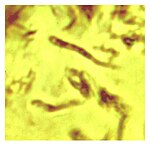 |
Fungi
[edit]newly named
[edit]| Name | Novelty | Status | Authors | Age | Unit | Location | Notes | Images |
|---|---|---|---|---|---|---|---|---|
|
Gen et sp nov |
Valid |
Smith, Currah, & Stockey |
Extinct bracket fungus |
|||||
|
Gen et sp nov |
Valid |
Smith, Currah, & Stockey |
Barremian (Cretaceous) |
Extinct bracket fungus. |
Plants
[edit]Newly named plants
[edit]| Name | Novelty | Status | Authors | Age | Unit | Location | Notes | Images |
|---|---|---|---|---|---|---|---|---|
|
Sp nov |
Valid |
Manchester & Dillhoff |
A beech tree species |
 | ||||
|
Sp nov. |
Valid |
Pigg, Ickert-Bond, & Wen |
Middle Miocene |
"Yakima Canyon Flora" |
A species of sweetgum |
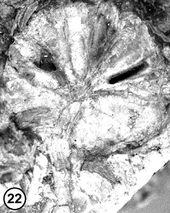 | ||
|
Sp nov |
Valid |
DeVore, Moore, Pigg, & Wehr |
oldest and only extinct species of Neviusia |
|||||
|
Sp nov |
Valid |
Manchester & Chen |
A betulaceous fruit |
Arthropoda
[edit]newly named arachnids
[edit]| Name | Novelty | Status | Authors | Age | Unit | Location | Notes | Images |
|---|---|---|---|---|---|---|---|---|
|
sp nov |
jr synonym[9] |
Wunderlich |
Unknown |
jr Synonym of Garcorops jadis |
||||
|
sp nov |
Valid |
Bosselaers |
Unknown |
Possibly extant, but copal age is not determined |
Newly named insects
[edit]| Name | Novelty | Status | Authors | Age | Unit | Location | Notes | Images |
|---|---|---|---|---|---|---|---|---|
|
Gen et sp nov |
valid |
Dlussky, Brothers & Rasnitsyn |
A Myrmicin ant, type species A. petrosa |
|||||
|
Gen et sp nov |
valid |
Dlussky, Brothers & Rasnitsyn |
A ponerin ant, two species |
|||||
|
Fam, gen et sp nov |
valid |
Koteja |
A scale insect, monotypic with Albicoccidae & A. dimai |
|||||
|
Fam, gen et sp nov |
valid |
Koteja |
A scale insect, monotypic with Burmacoccidae & B. danyi |
|||||
|
Comb nov |
valid |
(Mayr, 1868) |
Middle Eocene |
Baltic amber |
Fossil myrmicine ant |
 | ||
|
Sp nov |
jr synonym |
A stephanid wasp |
||||||
|
Gen et sp nov |
valid |
Nel & Perrault |
A stem group ant, |
 | ||||
|
gen et sp nov |
valid |
Koteja |
A scale insect, monotypic M. barbarae |
|||||
|
Gen et sp nov |
Valid |
Archibald |
A Berothid lacewing |
|||||
|
Gen et sp nov |
Valid |
Poinar |
A Phlebotomidae sand fly, type species P. burmitis |
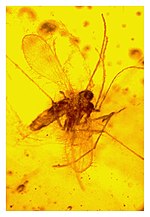 |
Molluscs
[edit]Cephalopods
[edit]| Name | Novelty | Status | Authors | Age | Unit | Location | Notes | Images |
|---|---|---|---|---|---|---|---|---|
| Conlinites[18] |
Gen et sp nov |
Valid |
Kennedy |
Early Cretaceous (Albian) |
An ammonite, type species is C. wrighti. |
|||
| Enigmaticeras[18] |
Gen et sp nov |
Valid |
Kennedy |
Early Cretaceous (Albian) |
An ammonite, type species is E. riceae. |
|||
| Ficheuria americana[18] |
Sp nov |
Valid |
Kennedy |
Early Cretaceous (Albian) |
An ammonite. |
|||
| Mariella (Mariella) asper[18] |
Sp nov |
Valid |
Kennedy |
Early Cretaceous (Albian) |
An ammonite. |
|||
| Neophlycticeras (Paradolphia) occidentalis[18] |
Sp nov |
Valid |
Kennedy |
Early Cretaceous (Albian) |
An ammonite. |
Newly named fishes
[edit]| Name | Novelty | Status | Authors | Age | Unit | Location | Notes | Images |
|---|---|---|---|---|---|---|---|---|
|
Sp. nov |
Valid |
Valiukevičius |
Late Silurian |
An acanthodian belonging to the group Ischnacanthiformes and the family Ischnacanthidae. |
||||
|
Sp. nov |
Valid |
Schultze & Märss |
Late Silurian |
A bony fish belonging to the group Lophosteiformes. |
||||
|
Sp. nov |
Valid |
Schultze & Märss |
Late Silurian |
A bony fish belonging to the group Lophosteiformes. |
||||
|
Sp. nov |
Valid |
Schultze & Märss |
Early Devonian |
A bony fish belonging to the group Lophosteiformes. |
||||
|
Sp. nov |
Valid |
Valiukevičius |
Late Silurian |
An acanthodian belonging to the group Climatiiformes and the family Climatiidae. |
||||
|
Sp. nov |
Valid |
Valiukevičius |
Late Silurian |
An acanthodian belonging to the group Climatiiformes and the family Climatiidae. |
||||
|
Gen. et sp. nov |
Valid |
Elliott, Mark-Kurik & Daeschler |
A member of Pteraspidiformes belonging to the group Psammosteida and the family Obrucheviidae. The type species is P. pulla |
|||||
|
Sp. nov |
Valid |
Valiukevičius |
Late Silurian |
An acanthodian belonging to the group Ischnacanthiformes and the family Poracanthidae. |
||||
|
Sp. nov |
Valid |
Valiukevičius |
Late Silurian |
An acanthodian belonging to the group Ischnacanthiformes and the family Poracanthidae. |
||||
|
Gen. et sp. nov |
Valid |
Žigaitė |
Dashtygoi Formation |
A thelodont, possibly a member of the group Phlebolepidiformes. The type species is T. rimae |
||||
|
Gen. et 2 sp. nov |
Valid |
Miller, Märss & Blom |
Late Silurian |
A member of Anaspida belonging to the group Birkeniida, possibly a member of the family Septentrioniidae. The type species is T. juncta; genus also includes T. concatenata. |
Newly named amphibians
[edit]| Name | Novelty | Status | Authors | Age | Unit | Location | Notes | Images |
|---|---|---|---|---|---|---|---|---|
|
Gen. et sp. nov |
Valid |
Lebedev |
A basal member of Tetrapoda. The type species is J. livnensis |
Reptile
[edit]Archosauromorphs
[edit]Newly named dinosaurs
[edit]Data courtesy of George Olshevsky's dinosaur genera list.[25]
| Name | Novelty | Status | Authors | Age | Unit | Location | Notes | Images |
|---|---|---|---|---|---|---|---|---|
|
Valid |
Currie & Varricchio |
 | ||||||
|
Gen et sp nov |
Valid |
Kuang |
Middle Jurassic |
|||||
|
Gen et sp nov |
Valid |
Parish & Barrett |
||||||
|
Gen et sp nov |
Valid |
Martinelli & Forasiepi |
Late Cretaceous |
|||||
|
Gen et sp nov |
Valid |
Apesteguía |
late Cretaceous |
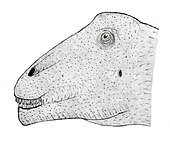 | ||||
|
Gen et sp nov |
Valid |
You, Ji, Lamanna, |
late Cretaceous |
|||||
|
Gen et sp nov |
Valid |
Early Cretaceous |
 | |||||
|
Gen et sp nov |
Valid |
Calvo, Rubilar-Rogers, & Moreno |
Late Cretaceous |
 | ||||
|
Valid |
Xing & Wang |
|||||||
|
Valid |
Hwang, Norell, Ji, & Gao |
 | ||||||
|
Valid |
Bolotsky & Godefroit |
Late Cretaceous |
||||||
|
Valid |
Salgado, Garrido, Cocca, & Cocca |
 | ||||||
|
Valid |
Xu & Norell |
 | ||||||
|
Valid |
Naish, Martill, & Frey |
 | ||||||
|
Preoccupied name |
Lü, Tomida, Azuma, |
Renamed Nemegtomaia |
||||||
|
Nomen nudum |
Zhao & Tan |
|||||||
|
Valid |
Chinnery |
 | ||||||
|
Valid |
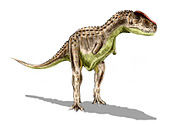 | |||||||
|
Valid |
Xu, & Wang |
|||||||
|
Valid |
Sereno, Wilson & Conrad |
A ceratosaur; new genus for |
||||||
|
Valid |
Harris & Dodson |
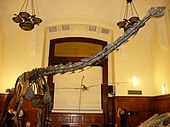 | ||||||
|
Valid |
Novas, Cambiaso, & Ambrosio |
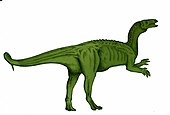 | ||||||
|
Valid |
Allain et al |
|||||||
|
Valid |
Leal, Azevedo, |
 |
Pterosaurs
[edit]New taxa
[edit]| Name | Status | Authors | Age | Unit | Location | Notes | |
|---|---|---|---|---|---|---|---|
|
Avgodectes |
Valid |
Peters |
Early Cretaceous |
A pterosaur hatchling. | |||
|
Valid |
Gasparini Fernández de la Fuente |
Late Jurassic (Oxfordian) |
|||||
|
Nomen Nudum |
Maisch Matzke Ge Sun |
Late Jurassic (Tithonian) |
|||||
|
Valid |
Maisch, M.W., Matzke, A.T., and Ge Sun |
Early Cretaceous (Aptian) |
|||||
Other archosauromorphs
[edit]| Name | Status | Authors Location | Notes | Images | |
|---|---|---|---|---|---|
| Crosbysaurus[48] | Valid non-dinosaurian taxon. | ||||
| Protecovasaurus[49] | Valid non-dinosaurian taxon. |
|
|||
Newly named birds
[edit]| Name | Status | Novelty | Authors | Age | Unit | Location | Notes | Images |
|---|---|---|---|---|---|---|---|---|
|
Valid |
Gen et sp. nov. |
An Enantiornithes, |
||||||
|
Valid |
Gen et sp. nov. |
An Anseranatidae, the type species of Anserpica Mourer-Chauviré, Berthet & Hugueney, 2004. |
||||||
|
Valid |
Gen et sp. nov. |
Middle Miocene |
A Psittacidae, the type species of Bavaripsitta Mayr & Göhlich, 2004. |
|||||
|
Valid |
Gen et sp. nov. |
A Phalacrocoracidae, the type species of Borvocarbo Mourer-Chauviré, Berthet & Hugueney, 2004. |
||||||
|
Valid |
Sp. nov. |
Early Oligocene |
A Gaviidae, not certain a species of Colymboides Milne-Edwards, 1868. |
|||||
|
Valid |
Gen et sp. nov. |
Early Oligocene |
A Trochilidae, the type species of Eurotrochilus Mayr, 2004. |
|||||
|
Valid |
Gen et sp. nov. |
|
An Ornithurae, the type species of Iaceornis Clarke, 2004. |
|||||
|
Valid |
Gen et sp. nov. |
An Enantiornithes, Euenantiornithes, the type species of Longirostravis Hou, Chiappe, Zhang et Chuong, 2004. |
||||||
|
Valid |
Gen et sp. nov. |
Late Quaternary |
A Turdidae, the type species of Meridiocichla Louchart, 2004. |
|||||
|
Valid |
Gen et sp. nov. |
Middle Meothis |
A Corvidae, the type species of Miopica Kurochkin & Sobolev, 2004. |
|||||
|
Valid |
Gen et sp. nov. |
Middle Miocene |
A Scolopacidae, the type species of Mirolia Ballmann, 2004. |
|||||
|
Valid |
Sp. nov. |
Middle Miocene |
A Scolopacidae. |
|||||
|
Valid |
Sp. nov. |
Middle Miocene |
A Scolopacidae, not certain to belong in Mirolia Ballmann, 2004. |
|||||
|
Valid |
Sp. nov. |
Middle Miocene |
A Scolopacidae. |
|||||
|
Valid |
Sp. nov. |
Middle Eocene |
A Primobucconidae Feduccia et Martin, 1976. |
|||||
|
Valid |
Sp. nov. |
Middle Eocene |
A Primobucconidae Feduccia et Martin, 1976. |
|||||
|
Valid |
Gen et sp. nov. |
Early Pliocene |
A Sulidae, the type species of Ramphastosula Stucchi & Urbina, 2004. |
|||||
|
Valid |
Sp. nov. |
Early-Middle Pleistocene |
A Tytonidae. |
|||||
|
Valid |
Gen et sp. nov. |
An Enentiornithes Walker, 1981, this is the type species of the new genus, most probably a junior synonym of Hebeiornis fengningensis Yan, 1999. |
||||||
|
Valid |
Gen et sp. nov. |
A Rallidae, the type species of Vitirallus Worthy, 2004. |
||||||
|
Valid |
Gen et sp. nov. |
Late Pleistocene or Early Holocene |
A Cathartidae, the type species of Wingegyps Alvarenga & Olson, 2004. |
Plesiosaurs
[edit]New taxa
[edit]| Name | Status | Authors | Age | Unit | Location | Notes |
|---|---|---|---|---|---|---|
| Plesiopterys | Valid | O'Keefe | Toarcian | Posidonienschiefer |
Synapsids
[edit]Non-mammalian
[edit]| Name | Status | Authors | Age | Unit | Location | Notes | Images |
|---|---|---|---|---|---|---|---|
| Ianthodon[66] | Valid | Kissel & Reisz | Kasimovian |  | |||
| Lobalopex[67] | Valid | Sidor, Hopson and Keyser | Lopingian | Teekloof Formation | |||
| Progalesaurus[68] | Valid | Sidor & Smith | Induan | Balfour Formation | |||
| Pyozia [69] | Valid | Anderson and Reisz | Capitanian | Krasnoschelsk Formation | |||
| Rewaconodon[70] | Valid | Datta, Das & Luo | Late Triassic | Tiki Formation |
Other Animals
[edit]| Name | Status | Authors | Age | Unit | Location | Notes | Images |
|---|---|---|---|---|---|---|---|
| Charniodiscus procerus | Valid | LaFlamme et al., 2004 | Ediacaran | Mistaken Point Formation and Trepassey Formation |
References
[edit]- ^ Gini-Newman, Garfield; Graham, Elizabeth (2001). Echoes from the past: world history to the 16th century. Toronto: McGraw-Hill Ryerson Ltd. ISBN 9780070887398. OCLC 46769716.
- ^ Poinar, G. (2008). "Lutzomyia adiketis sp. n. (Diptera: Phlebotomidae), a vector of Paleoleishmania neotropicum sp. n. (Kinetoplastida: Trypanosomatidae) in Dominican amber". Parasites & Vectors. 1 (1): 22. doi:10.1186/1756-3305-1-22. PMC 2491605. PMID 18627624.
- ^ a b Smith, S.Y.; Currah, R.S.; Stockey, R.A. (2004). "Cretaceous and Eocene poroid hymenophores from Vancouver Island, British Columbia". Mycologia. 96 (1): 180–186. doi:10.2307/3762001. JSTOR 3762001. PMID 21148842.
- ^ Manchester, S. R.; Dillhoff, R. M. (2004). "Fagus (Fagaceae) fruits, foliage, and pollen from the Middle Eocene of Pacific Northwestern North America". Canadian Journal of Botany. 82 (10): 1509–1517. doi:10.1139/b04-112.
- ^ Pigg, K. B.; Ickert-Bond, S. M.; Wen, J. (2004). "Anatomically preserved Liquidambar (Altingiaceae) from the middle Miocene of Yakima Canyon, Washington state, USA, and its biogeographic implications". American Journal of Botany. 91 (3): 499–509. doi:10.3732/ajb.91.3.499. PMID 21653405.
- ^ DeVore, M.L.; Moore, S.M.; Pigg, K.B.; Wehr, W.C. (2004). "Fossil Neviusia leaves (Rosaceae: Kerrieae) from the Lower Middle Eocene of Southern British Columbia". Rhodora. 12 (927): 197–209. JSTOR 23314752.
- ^ Manchester, S.R.; Pigg, K.B.; Crane, P.R. (2004). "Palaeocarpinus dakotensis sp. n. (Betulaceae: Coryloideae) and associated staminate catkins, pollen, and leaves from the Paleocene of North Dakota". International Journal of Plant Sciences. 165 (6): 1135–1148. doi:10.1086/423870.
- ^ Wunderlich, J. (2004). "Fossil spiders in amber and copal. Conclusions, revisions, new taxa and family diagnoses of fossil and extant taxa". Beiträge zur Araneologie. 3AB: 1–1908.
- ^ Penney, D.; Ono, H.; Selden, P.A. (2005). "A new synonymy for the Madagascan copal spider fauna (Araneae, Selenopidae)" (PDF). Journal of Afrotropical Zoology. 2: 41–44.[permanent dead link]
- ^ Bosselaers, J. (2004). "A new Garcorops species from Madagascar copal (Araneae: Selenopidae)" (PDF). Zootaxa. 445: 1–7. doi:10.11646/zootaxa.445.1.1. S2CID 47620450.
- ^ a b Dlussky, G. M.; Brothers, D. J.; Rasnitsyn, A. P. (2004). "The first Late Cretaceous ants (Hymenoptera: Formicidae) from southern Africa, with comments on the origin of the Myrmicinae". Insect Systematics and Evolution. 35: 1–13. doi:10.1163/187631204788964727.
- ^ a b c Koteja, J (2004). "Scale insects (Hemiptera: Coccinea) from cretaceous Myanmar (Burmese) amber". Journal of Systematic Palaeontology. 2 (2): 109–114. Bibcode:2004JSPal...2..109K. doi:10.1017/S1477201904001166. S2CID 86393735. – via Taylor & Francis (subscription required)
- ^ Fernández, F. (2004). "The American species of the myrmicine ant genus Carebara Westwood (Hymenoptera: Formicidae)". Caldasia. 26: 191–238.
- ^ Engel, M.S.; Ortega-Blanco, J. (2008). "The fossil crown wasp Electrostephanus petiolatus Brues in Baltic Amber (Hymenoptera, Stephanidae): designation of a neotype, revised classification, and a key to amber Stephanidae". ZooKeys (4): 55–64. Bibcode:2008ZooK....4...55E. doi:10.3897/zookeys.4.49. hdl:2445/36428.
- ^ Nel, A.; Perrault, G.; Perrichot, V.; Néradeau, D. (2004). "The oldest ant in the lower cretaceous amber of Charente-maritime (SW France) (Insecta: Hymenoptera: Formicidae)". Geologica Acta. 2 (1): 23–29.
- ^ Archibald, S.B.; Makarkin, V.N. (2004). "New genus of minute Berothidae (Neuroptera) from Early Eocene amber of British Columbia" (PDF). The Canadian Entomologist. 136: 61–76. CiteSeerX 10.1.1.552.2285. doi:10.4039/n03-043. S2CID 36459014. Archived from the original (PDF) on 2011-08-18. Retrieved 2010-04-09.
- ^ Poinar, G. O. Jr. (2004). "Palaeomyia burmitis (Diptera: Phlebotomidae), a new genus and species of Cretaceous sand flies with evidence of blood-sucking habits". Proceedings of the Entomological Society of Washington. 106: 598–605.
- ^ a b c d e Kennedy, W.J. (December 2004). "Ammonites from the Pawpaw Shale (Upper Albian) in northeast Texas". Cretaceous Research. 25 (6): 865–905. doi:10.1016/j.cretres.2004.08.005. ISSN 0195-6671.
- ^ a b c d e Valiukevičius, Juozas (2004). "Silurian acanthodian succession of the Lužni-4 borehole (Latvia)" (PDF). Acta Universitatis Latviensis. Earth and Environment Sciences. 679: 120–147.
- ^ a b c Schultze, Hans-Peter; Märss, Tiiu (2004). "Revisiting Lophosteus, a primitive osteichthyan" (PDF). Acta Universitatis Latviensis. Earth and Environment Sciences. 679: 57–78.
- ^ Elliott, David K.; Mark-Kurik, Elga; Daeschler, Edward B. (2004). "A revision of Obruchevia (Psammosteida: Heterostraci) and a description of a new obrucheviid from the Late Devonian of the Canadian Arctic" (PDF). Acta Universitatis Latviensis. Earth and Environment Sciences. 679: 22–45.
- ^ Žigaitė, Živilė (2004). "A new thelodont from Lower Silurian of Tuva and north-west Mongolia" (PDF). Acta Universitatis Latviensis. Earth and Environment Sciences. 679: 158–165.
- ^ Miller, C. Giles; Märss, Tiiu; Blom, Henning (2004). "New anaspid material from the Late Silurian of Britain and Estonia" (PDF). Acta Universitatis Latviensis. Earth and Environment Sciences. 679: 46–56.
- ^ Lebedev, Oleg A. (2004). "A new tetrapod Jakubsonia livnensis from the Early Famennian (Devonian) of Russia and palaeoecological remarks on the Late Devonian tetrapod habitats" (PDF). Acta Universitatis Latviensis. Earth and Environment Sciences. 679: 79–98.
- ^ Olshevsky, George. "Dinogeorge's Dinosaur Genera List". Archived from the original on 2011-07-15. Retrieved 2008-08-07.
- ^ Currie, P.J. and D.J. Varricchio. 2004. A new dromaeosaurid from the Horseshoe Canyon Formation (Upper Cretaceous) of Alberta, Canada. In: Feathered Dragons: Studies on the Transition from Dinosaurs to Birds (P.J. Currie, E.B. Koppelhus, M.A. Shugar, and J.L. Wright, eds.). Indiana University Press, Bloomington, IA: pp. 112-132.
- ^ Kuang, X.W. (2004). "A new Sauropoda from Kaijiang dinosaur fauna in middle Jurassic beds of North-Eastern Sichuan". In Sun, J.W. (ed.). Collection of the 90th anniversary of Tianjin museum of natural history. Tianjin: Tianjin Science and Technology Press. pp. 40–46.
- ^ Parish, J.; Barrett, P.M. (2004). "A reappraisal of the ornithischian dinosaur Amtosaurus magnus Kurzanov and Tumanova 1978, with comments of the status of A. archibaldi Averianov 2002". Canadian Journal of Earth Sciences. 41 (3): 299–306. Bibcode:2004CaJES..41..299P. doi:10.1139/e03-101.
- ^ Martinelli, A.G. (2004). "Late Cretaceous vertebrates from Bajo de Santa Rosa (Allen Formation), Rio Negro province, Argentina, with the description of a new sauropod dinosaur (Titanosauridae)". Revista del Museo Argentino de Ciencias Naturales. Nueva Series. 6 (2): 257–305. doi:10.22179/REVMACN.6.88.
- ^ Apestegua, S. (2004). ""Bonitasaura salgadoi" gen. et sp. nov.: a beaked sauropod from the Late Cretaceous of Patagonia". Naturwissenschaften. 91 (10): 493–497. Bibcode:2004NW.....91..493A. doi:10.1007/s00114-004-0560-6. PMID 15729763. S2CID 33590452.
- ^ You, H.; Ji, Q.; Lamanna, M.C.; Li, J. (2004). "A titanosaurian sauropod dinosaur with opisthocoelous caudal vertebrae from the Early Late Cretaceous of Liaoning Province, China". Acta Geologica Sinica. 78 (4): 907–911. Bibcode:2004AcGlS..78..907Y. doi:10.1111/j.1755-6724.2004.tb00212.x. S2CID 131081738.
- ^ Xu, X.; Norell, M.A.; Kuang, X.; Wang, X.; Zhao, Q.; Jia, C. (2004). "Basal tyrannosauroids from China and evidence for protofeathers in tyrannosauroids" (PDF). Nature. 431 (7009): 680–684. Bibcode:2004Natur.431..680X. doi:10.1038/nature02855. PMID 15470426. S2CID 4381777.
- ^ Calvo, J.O.; Rubilar-Roger, D.; Moreno, K. (2004). "A new Abelisauridae (Dinosauria: Theropoda) from northwest Patagonia". Ameghiniana (Rev. Asoc.Paleontol. Argent.). 41 (4): 555–563.
- ^ Xu, X.; Wang, X.-L. (2004). "A New Dromaeosaur (Dinosauria: Theropoda) from the Early Cretaceous Yixian Formation of Western Liaoning". Vertebrata PalAsiatica. 42 (2): 11–119. doi:10.19615/j.cnki.1000-3118.2004.02.002.
- ^ Hwang, S.H.; Norell, M.A.; Ji, Q.; Gao, K. (2004). "Large compognathid from the Early Cretaceous Yixian Formation of China" (PDF). Journal of Systematic Palaeontology. 2 (1): 13–30. Bibcode:2004JSPal...2...13H. doi:10.1017/S1477201903001081. S2CID 86321886.
- ^ Bolotsky, Yu.L.; Godefroit, P. (2004). "A new hadrosaurine dinosaur from the Late Cretaceous of far Eastern Russia". Journal of Vertebrate Paleontology. 24 (2): 351–365. Bibcode:2004JVPal..24..351B. doi:10.1671/1110. S2CID 130691286.
- ^ Salgado, L.; Garrido, A.; Cocca, S.E.; Cocca, J.R. (2004). "Lower Cretaceous rebbachisaurid sauropods from Cerro Aguada del Leon (Lohan Cura Formation), Neuquen Province, northwestern Patagonia, Argentina". Journal of Vertebrate Paleontology. 24 (4): 903–912. doi:10.1671/0272-4634(2004)024[0903:LCRSFC]2.0.CO;2. S2CID 129233849.
- ^ Xu, X.; Norell, M.A. (2004). "A new troodontid dinosaur from China with avian-like sleeping posture" (PDF). Nature. 431 (7010): 838–841. Bibcode:2004Natur.431..838X. doi:10.1038/nature02898. PMID 15483610. S2CID 4362745.
- ^ Naish, D.; Martill, D.M.; Frey, E. (2004). "Ecology, systematics and biogeographical relationships of dinosaurs, including a new theropod, from the Santana Formation (?Albian, Early Cretaceous) of Brazil". Historical Biology. 16 (2–4): 1–14. Bibcode:2004HBio...16...57N. CiteSeerX 10.1.1.394.9219. doi:10.1080/08912960410001674200. S2CID 18592288.
- ^ Lu, J., Y. Tomida, Y. Azuma, Z.-M. Dong, and Y.- N. Lee. 2004. New oviraptorid dinosaur (Dinosauria: Oviraptorosauria) from the Nemegt Formation of southwestern Mongolia. Bulletin of the National Science Museum, Tokyo (Series C) 30: pp. 95-130.
- ^ Chinnery, B.J. (2004). "Description of "Prenoceratops pieganensis" gen et sp. nov. (Dinosauria: Neoceratopsia) from the Two Medicine Formation of Montana". Journal of Vertebrate Paleontology. 24 (3): 572–590. doi:10.1671/0272-4634(2004)024[0572:DOPPGE]2.0.CO;2. S2CID 86541770.
- ^ a b Sereno, P.C., J.A. Wilson, and J.L. Conrad. 2004. New dinosaurs link southern landmasses in the Mid-Cretaceous. Proceedings of the Royal Society of London (Series B) published online: pages 1-6.
- ^ Xu, X.; Wang, X. (2004). "A new troodontid (Theropoda: Troodontidae) from the Lower Cretaceous Yixian Formation of Western Liaoning, China". Acta Geologica Sinica - English Edition. 78 (1): 22–26. Bibcode:2004AcGlS..78...22X. doi:10.1111/j.1755-6724.2004.tb00671.x. S2CID 129952609.
- ^ Harris, J.D.; Dodson, P. (2004). "A new diplodocoid sauropod dinosaur from the Upper Jurassic Morrison Formation of Montana, USA". Acta Palaeontologica Polonica. 49 (2): 197–210.
- ^ Novas, F.E.; Cambiaso, A.V.; Ambrosio, A. (2004). "A new basal iguanodontian (Dinosauria, Ornithischia) from the Upper Cretaceous of Patagonia". Ameghiniana. 41 (1): 75–85.
- ^ Allain, R.; Aquesbi, N.; Dejax, J.; Meyer, C.; Monbaron, M.; Montenat, C.; Richir, P.; Rochdy, M.; Russell, D.; Taquet, P. (2004). "A basal sauropod dinosaur from the Early Jurassic of Morocco" (PDF). Comptes Rendus Palevol. 3 (3): 199–208. Bibcode:2004CRPal...3..199A. doi:10.1016/j.crpv.2004.03.001.
- ^ Leal; Azevedo, S.A.K.; Kellner, A.W.A.; da Rosa, A.A.S. (2004). "A new early dinosaur (Sauropodomorpha) from the Caturrita Formation (Late Triassic), Paraná Basin, Brazil". Zootaxa. 690: 1–24. doi:10.11646/zootaxa.690.1.1.
- ^ Heckert, A.B. 2004. Late Triassic microvertebrates from the lower Chinle Group (Otischalkian-Adamanian: Carnian), southwestern U.S.A. New Mexico Museum of Natural History and Science, Bulletin 27: 170 pages.
- ^ Heckert, A.B. 2004. Late Triassic microvertebrates from the lower Chinle Group (Otischalkian-Adamanian: Carnian), southwestern U.S.A. New Mexico Museum of Natural History and Science Bulletin 27: 170 pages.
- ^ Gong Enpu; Hou Lianhai; Wang Lixia (2004). "Enantiornithine Bird with Diapsidian Skull and Its Dental Development in the Early Cretaceous in Liaoning, China". Acta Geologica Sinica. 78 (1): 1–7. Bibcode:2004AcGlS..78....1G. doi:10.1111/j.1755-6724.2004.tb00668.x. S2CID 129218847.
- ^ a b Cécile Mourer-Chauviré; Didier Berthet; Marguerite Hugueney (2004). "The Late Oligocene of the Créchy Quarry (Allier, France), with a Description of Two New Genera (Aves: Pelecaniformes: Phalacrocoracidae, and Anseriformes: Anseranatidae)". Senckenbergiana Lethaea. 84 (1–2): 303–315. doi:10.1007/bf03043473. S2CID 84323461.
- ^ Gerald Mayr; Ursula B. Göhlich (2004). "A New Parrot from the Miocene of Germany, with Comments on the Variation of Hypotarsus Morphology in Some Psittaciformes" (PDF). Belgian Journal of Zoology. 134 (1): 47–54.
- ^ Gerald Mayr (2004). "A Partial Skeleton of a New Fossil Loon (Aves, Gaviiformes) from the Early Oligocene of Germany with Preserved Stomach Content" (PDF). Journal of Ornithology. 145 (4): 281–286. doi:10.1007/s10336-004-0050-9. S2CID 1070943. Archived from the original (PDF) on 2015-09-24. Retrieved 2014-07-26.
- ^ Gerald Mayr (2004). "Old World Fossil Record of Modern-Type Hummingbirds". Science. 304 (5672): 861–864. Bibcode:2004Sci...304..861M. doi:10.1126/science.1096856. PMID 15131303. S2CID 6845608.
- ^ Julia A. Clarke (2004). "Morphology, Phylogenetic Taxonomy, and Systematics of Ichthyornis and Apatornis (Avialae: Ornithurae)" (PDF). Bulletin of the American Museum of Natural History. 286: 1–179. doi:10.1206/0003-0090(2004)286<0001:mptaso>2.0.co;2. hdl:2246/454. S2CID 84035285. Archived from the original (PDF) on 2013-10-30. Retrieved 2014-07-26.
- ^ Hou Lianhai; Luis M. Chiappe; Zhang Fucheng; Chuong Cheng-Ming (2004). "New Early Cretaceous Fossil from China Documents a Novel Trophic Specialization for Mesozoic Birds". Naturwissenschaften. 91 (1): 22–25. Bibcode:2004NW.....91...22H. doi:10.1007/s00114-003-0489-1. PMC 4382005. PMID 14740099.
- ^ Antoine Louchart (2004). "An Extinct Large Thrush (Aves: Turdidae) from the Late Quaternary of Mediterranean Europe". Neues Jahrbuch für Geologie und Paläontologie, Abhandlungen. 233 (2): 275–296. doi:10.1127/njgpa/233/2004/275.
- ^ Evgeny N. Kurochkin; Denis V. Sobolev (2004). "Miopica paradoxa gen. et sp n. - New Genus and Species of the Miocene Magpie" (PDF). Vestnik Zoologii. 38 (6): 87–90.
- ^ a b c d Peter Ballmann (2004). "Fossil Calidrinae (Aves: Charadriiformes) from the Middle Miocene of the Nördlinger Ries" (PDF). Bonner Zoologische Beiträge. 52 (1–2): 101–114.
- ^ a b Gerald Mayr; Cécile Mourer-Chauviré; Ilka Weidig (2004). "Osteology and Systematic Position of the Eocene Primobucconidae (Aves, Coraciiformes Sensu Stricto), with First Records from Europe" (PDF). Journal of Systematic Palaeontology. 2 (1): 1–12. Bibcode:2004JSPal...2....1M. doi:10.1017/s1477201903001093. S2CID 34962540. Archived from the original (PDF) on 2012-02-25. Retrieved 2014-07-26.
- ^ Marcelo Stucchi; Mario Urbina (2004). "Ramphastosula (Aves, Sulidae): a New Genus from the Early Pliocene of the Pisco Formation, Peru" (PDF). Journal of Vertebrate Paleontology. 24 (4): 974–978. doi:10.1671/0272-4634(2004)024[0974:rasang]2.0.co;2. S2CID 28789007.
- ^ Marco Pavia (2004). "A New Large Barn Owl (Aves, Strigiformes, Tytonidae) from the Middle Pleistocene of Sicily, Italy, and it's Taphonomical Significans" (PDF). Geobios. 37 (5): 631–641. Bibcode:2004Geobi..37..631P. doi:10.1016/j.geobios.2003.05.007. hdl:2318/84927. S2CID 31475664.
- ^ Zhang Fucheng; Per G.P. Ericson; Zhou Zhonghe (2004). "Description of a New Enantiornithine Bird from the Early Cretaceous of Hebei, Northern China" (PDF). Canadian Journal of Earth Sciences. 41 (9): 1097–1107. Bibcode:2004CaJES..41.1097Z. doi:10.1139/e04-055. Archived from the original (PDF) on 2014-10-23. Retrieved 2014-08-04.
- ^ Trevor H. Worthy (2004). "The Fossil Rails (Aves: Rallidae) of Fiji with Descriptions of a New Genus and Species" (PDF). Journal of the Royal Society of New Zealand. 34 (3): 295–314. Bibcode:2004JRSNZ..34..295W. doi:10.1080/03014223.2004.9517768. S2CID 129705107. Archived from the original (PDF) on 2014-07-29. Retrieved 2014-07-26.
- ^ Herculano M. Alvarenga; Storrs L. Olson (2004). "A New Genus of Tiny Condor from the Pleistocene of Brazil (Aves: Vulturidae)" (PDF). Proceedings of the Biological Society of Washington. 117 (1): 1–9.
- ^ Kissel, R.A. & Reisz, R.R. "Synapsid fauna of the Upper Pennsylvanian Rock Lake Shale near Garnett, Kansas and the diversity pattern of early amniotes". In G. Arratia, M. V. H. Wilson & R. Cloutier (eds.). Recent Advances in the Origin and Early Radiation of Vertebrates. Verlag Dr. Friedrich Pfeil, 2004.
- ^ Sidor, C.A.; Hopson, J.A.; Keyser, A.W. (2004). "A new burnetiamorph theraspid from the Teekloof Formation, Permian, of South Africa". Journal of Vertebrate Paleontology. 24 (4): 938–950. doi:10.1671/0272-4634(2004)024[0938:ANBTFT]2.0.CO;2. S2CID 85752458.
- ^ Sidor, C.A.; Smith, R.M.H. (2004). "A new galesaurid (Therapsida: Cynodontia) from the Lower Triassic of South Africa". Palaeontology. 47 (3): 535–556. Bibcode:2004Palgy..47..535S. doi:10.1111/j.0031-0239.2004.00378.x. S2CID 129906726.
- ^ Anderson, J.S.; Reisz, R.R. (2004). "Pyozia mesenensis, a new, small varanopid (Synapsida, Eupelycosauria) from Russia: "Pelycosaur" diversity in the Middle Permian". Journal of Vertebrate Paleontology. 24 (1): 173–179. Bibcode:2004JVPal..24..173A. doi:10.1671/1940-13. S2CID 59023934.
- ^ Datta, P.M.; Das, D.P.; Luo, Z.-X. (2004). "A Late Triassic dromatheriid (Synapsida: Cynodontia) from India". Annals of Carnegie Museum. 73 (2): 12–24. doi:10.5962/p.215151. S2CID 90271923.
